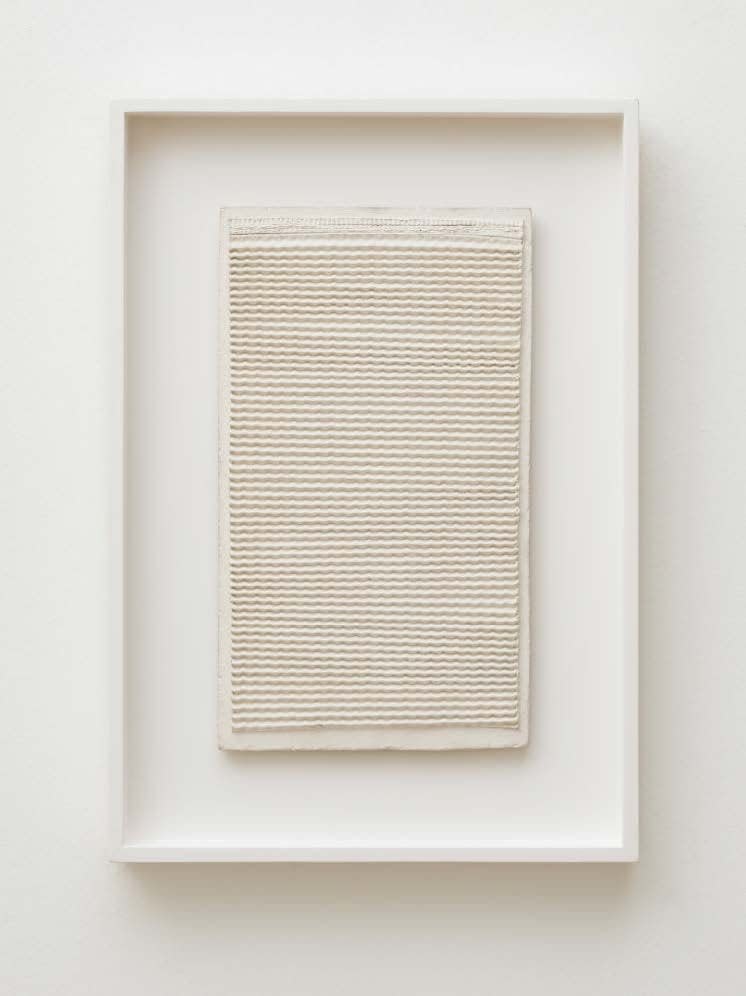
Jan Schoonhoven Dutch, 1914-1994
13 3/4 x 7 7/8 inches
In 1964, the Dutch Nul group exhibited with German Zero artists Heinz Mack, Otto Piene and Günther Uecker at the Gemeentemuseum, The Hague. Under the exhibition title ‘Zero-0-Nul’, Jan Schoonhoven, Armando and Henk Peeters emphasised the specifically Dutch character of their ZERO-works. This was reflected in a predilection for industrial materials and a nod to ready-mades, to everyday objects ‘declared as art’. Jan Schoonhoven showed in The Hague his installation Kartonwand (1964), a stacking of unprocessed strips of rib cardboard. In retrospect, Schoonhoven judged this method of working as ‘truly ZERO’ because, after all, it originated ‘(...) from ZERO theories, the isolation of materials that thereby acquire a new reality.’[1] In the context of this statement, the relief Zig-Zag (1965) is of particular significance. In 1964, barely a year before the creation of the relief Zig-Zag, Schoonhoven formulated the benchmarks of ZERO in an artist’s text. The artist ‘merely chooses isolated parts of reality’ and thereby accepts reality. According to Schoonhoven, if the artist intervenes at all, it is only ‘to show reality in a more intense way.’ Within Schoonhoven's oeuvre, relief Zig-Zag is pre eminently a demonstration of these ZERO principles. And a unique one at that, because it is not very often that a relief has such a strong character of a readymade. A cardboard wrapper, which served to protect a purchased bottle of gin (Dutch jenever), Schoonhoven isolated as a ‘ZERO structure’, the latter reinforced by the white paint skin. That the relief was a gift for photographer Truus Peeters-Nienhuis, spouse of Schoonhoven's fellow group member Henk Peeters, attests to the close bond between the Zero artists – and also makes it a testament to ZERO’s history.
[1] Flip Bool and Enno Develing, typescript, unpublished interview with Jan Schoonhoven, 11 January 1984, Henk Peeters Archive, RKD, Netherlands Institute for Art History, The Hague. Cited in: Antoon Melissen, Jan Schoonhoven, Rotterdam 2015, p. 88.
[2] Jan Schoonhoven, ‘Zero’, De nieuwe stijl. Werk van de internationale avant-garde 1 (1965), p. 118-123.
Provenance
The artist
Collection Henk and Truus Peeters, Hall. Received as a gift from the artist
Private collection, The Netherlands
Exhibitions
Essen, Museum Folkwang, Jan J. Schoonhoven - retrospektiv, 1995, travelling to;
The Netherlands, Maastricht, Bonnefantenmuseum,
Switzerland, Aarau, Aargauer Kunsthaus
Literature
Finckh, Gerhard, Jan J. Schoonhoven – retrospektiv, exh.cat Essen / Maastricht / Aarau (Museum Folkwang / Bonnefantenmuseum / Aargauer Kunsthaus) 1995, p. 116 (ill.)
